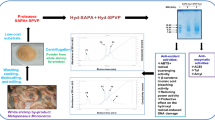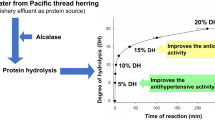Abstract
Fish protein hydrolysates with different degrees of hydrolysis were prepared from muscle and heads of red scorpionfish (Scorpaena notata) by treatment with different proteases (Flavourzyme, Trypsin from bovine pancreas and crude enzyme preparations from the intestines of red scorpionfish and from the fungus Penicillium digitatum). The antioxidant and the antihypertensive activities of the hydrolysates were tested. The antioxidant power was evaluated through DPPH free radical scavenging activity, reducing power and metal chelating activity. All hydrolysates showed different degrees of hydrolysis and varying degrees of antioxidant activity. The hydrolysates obtained by treatment with crude enzyme preparations exhibited the highest antioxidant activity. Further, red scorpionfish head protein hydrolysates obtained with fungal protease and with fish crude protease were found to strongly inhibit the angiotensin-I converting enzyme (IC50 of 0.489 and 0.901 mg/ml, respectively). These results suggested that hydrolysates of red scorpionfish obtained by treatment with crude enzyme preparations would be a beneficial ingredient for functional food or pharmaceuticals against hypertension.







Similar content being viewed by others
References
Abidi F, Aissaoui N, Chobert JM, Hertle T, Marzouki MN (2014) Neutral serine protease from Penicillium italicum purification, biochemical characterization, and use for antioxidative peptide preparation from Scorpaena notata muscle. Appl Biochem Biotechnol 174:186–205
Adler-Nissen J (1986) A review of food hydrolysis specific areas. In: Adler-Nissen J (ed) Enzymic hydrolysis of food proteins. Elsevier Applied Science Publishers, Copenhagen, pp 57–109
Aissaoui N, Abidi F, Mahat S, Marzouki MN (2014) Purification and biochemical characterization of a novel protease from Penicillium digitatum – use in bioactive peptides production. J Basic Microbiol 54:178–189
Arihara K (2006) Strategies for designing novel functional meat products. Meat Sci 74:219–229
Balti R, Nedjar-Arroume N, Bougatef A, Guillochon D et al (2010) Three novel angiotensin I-converting enzyme (ACE) inhibitory peptides from cuttlefish (Sepia officinalis) using digestive proteases. Food Res Int 43:1136–1143
Batista I, Ramos C, Coutinho J, Bandarra NM, Nunes ML (2010) Characterization of protein hydrolysates and lipids obtained from black scabbardfish (Aphanopus carbo) by-products and antioxidative activity of the hydrolysates produced. Process Biochem 45:18–24
Ben Khaled H, Ktari N, Ghorbel-Bellaaj O, Jridi M, Lassoued I, Nasri M (2011) Composition, functional properties and in vitro antioxidant activity of protein hydrolysates prepared from sardinelle (Sardinella aurita) muscle. J Food Sci Technol 51(4):622–633
Benjakul S, Morrissey MT (1997) Protein hydrolysates from Pacific whiting solid wastes. J Agric Food Chem 45:3423–3430
Bougatef A, Nedjar-Arroume N, Manni L, Ravallec R, Barkia A, Guillochon D, Nasri M (2010) Purification and identification of novel antioxidant peptides from enzymatic hydrolysates of sardinelle (Sardinella aurita) by-products proteins. Food Chem 118:559–565
Bradford MM (1976) A rapid and sensitive method for the quantitation of microgram quantitites of protein utilizing the principle of protein-dye binding. Anal Biochem 72:248–254
Cai L, Wu X, Lv Y, Xu Y, Mi G, Li J (2014) The neuroprotective and antioxidant activities of protein hydrolysates from grass carp (Ctenopharyngodon idella) skin. J Food Sci Technol. doi:10.1007/s13197-014-1438-z
Decker EA, Welch B (1990) Role of ferritin as a lipid oxidation catalyst in muscle food. J Agric Food Chem 38:674–677
FAO (2014) The state of world fisheries and aquaculture 2012: opportunities and challenges. Food and Agricultural Organization of the United Nation, Rome, pp 4–7
Ferreira ICFR, Baptista P, Vilas-Boas M, Barros L (2007) Free-radical scavenging capacity and reducing power of wild edible mushrooms from north east Portugal. Food Chem 100:1511–1516
He HL, Chen XL, Wu H, Sun CY et al (2007) High throughput and rapid screening of marine protein hydrolysates enriched in peptides with angiotensin-I converting enzyme inhibitory activity by capillary electrophoresis. Bioresour Technol 98:3499–3505
Hinsberger A, Sandhu BK (2004) Digestion and absorption. Curr Paediatr 14:605–611
Je JY, Lee KH, Lee MH, Ahn CB (2009) Antioxidant and antihypertensive protein hydrolysates produced from tuna liver by enzymatic hydrolysis. Food Res Int 42:1266–1272
Jellouli K, Bougatef A, Daassi D, Balti R, Barkia A, Nasri M (2009) New alkaline trypsin from the intestine of Grey triggerfish (Balistes capriscus) with high activity at low temperature: purification and characterization. Food Chem 116:644–650
Jun SY, Park PJ, Jung WK, Kim SK (2004) Purification and characterization of an antioxidative peptide from enzymatic hydrolysate of yellowfin sole (Limanda aspera) frame protein. Eur Food Res Technol 219:20–26
Klompong V, Benjakul S, Kantachote D, Shahidi F (2007) Antioxidative activity and functional properties of protein hydrolysate of yellow stripe trevally (Selaroides leptolepis) as influenced by the degree of hydrolysis and enzyme type. Food Chem 102:1317–1327
Kristinsson HG, Rasco BA (2000) Biochemical and functional properties of Atlantic salmon (Salmo salar) muscle hydrolyzed with various alkaline proteases. J Agric Food Chem 48:657–666
Matsufuji H, Matsui T, Seki E, Osajima K, Nakashima M, Osajima Y (1994) Angiotensin I-converting enzyme inhibitory peptides in an alkaline protease hydrolyzate derived from sardine muscle. Biosci Biotechnol Biochem 58:2244–2245
Morais HA, Silvestre MPC, Silva MR, Silva VDM, Batista MA et al (2013) Enzymatic hydrolysis of whey protein concentrate: effect of enzyme type and enzyme:substrate ratio on peptide profile. J Food Sci Technol. doi:10.1007/s13197-013-1005-z
Nakamura Y, Yamamoto N, Sakai K, Okubo A et al (1995) Purification and characterization of angiotensin Iconverting- enzyme inhibitors from sour milk. J Dairy Sci 78:777–783
Ono S, Hosokawa M, Miyashita K, Takahashi K (2003) Isolation of peptides with angiotensin I-converting enzyme inhibitory effect derived from hydrolysate of upstream chum salmon muscle. J Food Sci 68:1611–1614
Oyaizu M (1986) Studies on product of browning reaction prepared from Glucose amine. Jpn J Nutr 44:307–315
Qian ZJ, Je JY, Kim SK (2007) Antihypertensive effect of angiotensin I converting enzyme-inhibitory peptide from hydrolysates of bigeye tuna dark muscle, thunnus obesus. J Agric Food Chem 55:8398–8403
Saiga A, Tanabe S, Nishimura T (2003) Antioxidant activity of peptides obtained from porcine myofibrillar proteins by protease treatment. J Agric Food Chem 51:3661–3667
Segers R, But TM, Kerry BR, Peberdy JF (1994) The nematophagous fungus Verticillium chlamydosporium produces a chymoelastase-like protease which hydrolyses host nematode proteins in situ. Microbiologica 140:2715–2723
Schmidt TM, Bleakley B, Nealson KH (1988) Characterization of an extracellular protease from the insect pathogen Xenorhabdus luminescens. Appl Environ Microbiol 54:2793–2797
Spellman D, McEvoy E, O’Cuinn G, FitzGerald RJ (2003) Proteinase and exopeptidase hydrolysis of whey protein: comparison of the TNBS, OPA and pHstat methods for quantification of degree of hydrolysis. Int Dairy J 13:447–453
Suthasinee N, Sittiwat L, Manop S, Apinya A (2005) Optimization of enzymatic hydrolysis of fish soluble concentrate by commercial proteases. J Food Eng 70:571–578
Wu HC, Chen HM, Shiau CY (2003) Free amino acids and peptides as related to antioxidant properties in protein hydrolysates of mackerel (Scomber austriasicus). Food Res Int 36:949–957
Yen GC, Wu JY (1999) Antioxidant and radical properties of extracts from Ganoderma Tsugae. Food Chem 65(3):375–379
Acknowledgments
This work was supported by the financial project of LIP-MB Laboratory, INSAT, Carthage University, Ministry of Higher Education and Scientific Research of Tunisia.
Author information
Authors and Affiliations
Corresponding author
Rights and permissions
About this article
Cite this article
Aissaoui, N., Abidi, F. & Marzouki, M.N. ACE inhibitory and antioxidant activities of red scorpionfish (Scorpaena notata) protein hydrolysates. J Food Sci Technol 52, 7092–7102 (2015). https://doi.org/10.1007/s13197-015-1862-8
Revised:
Accepted:
Published:
Issue Date:
DOI: https://doi.org/10.1007/s13197-015-1862-8




